San Francisco’s Planning Commission has approved the plans for Forest City’s massive 5M Project, a development which spans a 4-acre South of Market site bounded by Mission, Fifth, Howard and Mary Streets and includes the redevelopment of the iconic Chronicle Building.
In addition to 688 residences, a mix of 400 market-rate condos and mostly market-rate apartments, the project would yield 600,000 new square feet of office space; 69,000 square feet of retail, restaurant, and cultural uses; and 49,000 square feet of public open space, not including the proposed conversion of Mary Street, between Mission and Minna, into a pedestrian-only alley leading to a new Mary Court.
Currently only zoned for development up to 160-feet in height, San Francisco’s Board of Supervisors will need to approve an up-zoning of the 5M project’s parcels for the towers as designed by Kohn Pedersen Fox Associates for Forest City and the Hearst Corporation to rise up to 470-feet on the site.
If the up-zoning is approved and survives any legal or targeted ballot measure challenges, construction for the 5M Project could start as early as 2017 and would span an estimated eight years to complete.
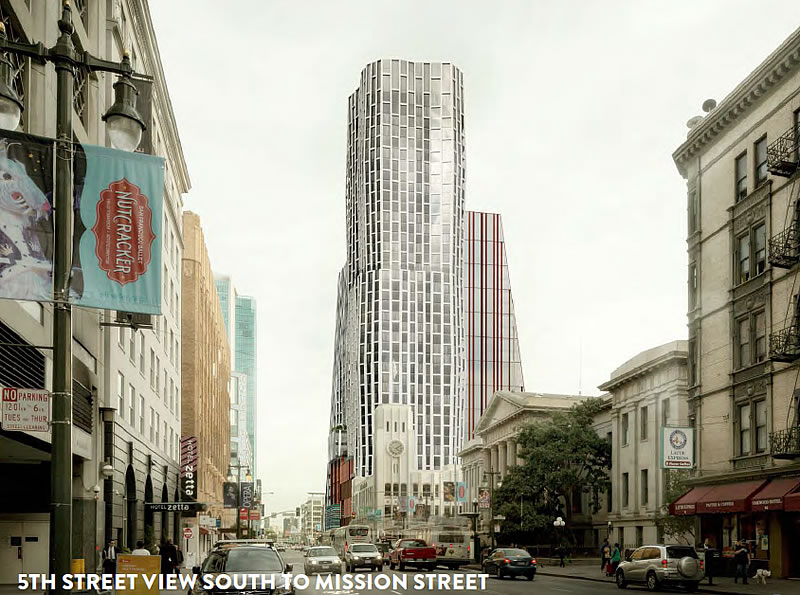
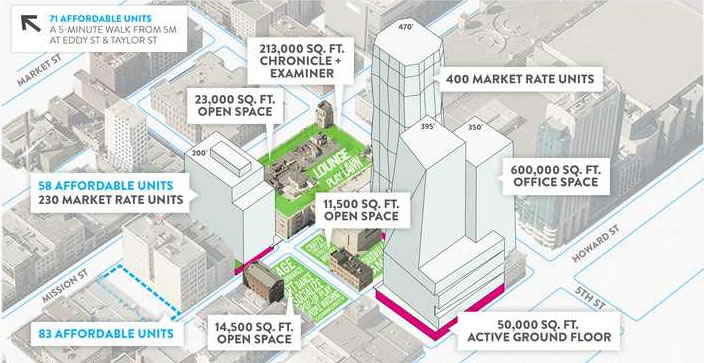
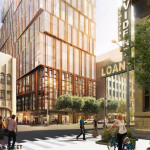
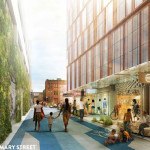
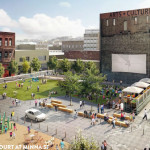

7-0 / 5-2
shows who is in charge of SF…..
without a revised planning commission and SFBOS we will only see growth without any questioning on capacity of the city….the needs of the existing community and their concerns,
how much transit fee will be paid by this development, none, they will have 5M empty luxury buses, cruising the mission, while the employee’s leave their tesla’s in the garages while they fly overseas….
typical now in SF
I see plenty of questioning of projects, projects getting changed, delayed and/or stopped and abandoned. Not sure what city you are referring to, but it is certainly not San Francisco.
haha, indeed. Nice to see Commissioners thinking of the majority who need lower market rate rents.
Haha – The same obstructionists showed up and got slapped down. I can’t wait for this city to be 100% gentrified by poor rent control policies. Bye bye Anti-Eviction project – go to Modesto
yeah, people with common sense are in charge of SF. cities shouldn’t be empty parking lots and dying newspaper buildings. the 33% affordable payout is beyond what’s required.
The existing community was far from unanimous on this. There were many community groups which wanted the development – and no, they werent being bought off. When it came down to it – as someone who watched almost all of the testimony – the opponents were completely unable to provide a convincing narrative on why a continuance would be good and/or necessary.
When the opponents failed, they reacted like children and stopped the meeting with a “peoples fillibuster.” 7 out of ten of the opponents were opposing the project for reasons which the planning dept had no purview over – e.g. they wanted a filipino cultural district. Most San Franciscans have absolutely no idea what the planning commission does.
Sociopaths like “Hitman” aside, I think that’s right. This isn’t an example of a relatively unified community opposing a project. The community and various nonprofits were quite divided – and a lot of the opposition was about the Filipino Heritage District – which didn’t really have anything to do with this specific project. Which is why ultimately the objections failed. Plus, as one of the commissioners noted – this is not a project that just came out of the woodwork. Its been going through an extensive review process for over 3 years.
Over 7 years, and people claimed it wasn’t long enough
filipino cultural district is in Daly City and part of SSF and Colma.
SF needs to approve more projects faster! I am glad that some of those bad guys have left SF.
It does make one wonder why we bother to go through the entire zoning process if the end result is that the zoning limits can be ignored when someone wants to build a bigger building. And, of course, all the more subjective elements that are included are just ignored.
Because I think that also implies ministerial approvals which we in SF cannot have as every single project must be debated whether it conforms to zoning or requires spot zoning.
We could not handle a transparent and quick process
At least they are trying to put all the city’s ugliest buildings at the same intersection.
That intersection needs change. Build it.
Atrocious looking project. This hopefully will never get built.
All of San Francisco needs to be up-zoned. We can easily fit ~2 million people in this city and far too many lots are being under-built.
Why stop at 2 Million? If you don’t care about what it is like to live in the City (and you obviously don’t), then there is no reason to arbitrarily limit developers’ profits to a 2 million population.
Noe, there is no way to limit the population of any city. People can live where they want. However, while many people may enjoy San Francisco, most people do not want to live in the San Francisco. It is not just the price, but there are many people who could easily afford to live in San Francisco (like millionaires who live in LA, or Indianapolis, or anywhere else in the U.S.) who chose not to because their family, friends, work and general lives are not located here.
The notion that there is an unlimited demand to live in San Francisco is a fantasy.
That said, arbitrarily trying to prevent any new development in the hopes that no one will move here is ridiculous, too. All that does increase the housing and office development pressure for everyone here and ensure that everything stays more expensive than it needs to be. San Francisco NEVER will be an “affordable” place to live, but it does not have to be an astronomically priced place where there is no hope of anyone except for multi-millionaires and billionaires surviving here.
MUNI MELTDOWN!
“We can easily fit ~2 million people…”
And nobody would be able to get in or out.
Don’t worry. The city will clear out again after the next tech crash as it did after the last one.
And if we allow more building now, think of how affordable things will become after everyone “clears out”.
I believe in up-zoning and increasing density but unfortunately I agree that nobody would be able to get in or out. People were stranded in the city when that storm closed down 280.
agree, public transit is a nighttmare and there is not enough freeway acess.
Go ahead and build it. I’ll have cashed out before it’s finished.
With improved Bart and transit (2nd transbay tube?) , SF could have 2 million citizens and still have much less density than Manhattan
It takes more than improved transit to accommodate 2 million people in a 7×7 plot of land. Even at 800,000 people SF is in desperate need of transit and infrastructure upgrades.
Since when is more people better (especially since there is basically zero infrastructure improvement)? Is 10 million people 5x better than 2 million people?
I can’t wait for the world economy to collapse, tons of sham startups to fail and for tens of thousands of hipsters to leave SF permanently. It has happened before and will happen again.
You can’t wait for “the world economy to collapse”…an event that will inflict abject misery and poverty on millions across the globe? And would also severely damage the lives of anybody working in a service related industry in our region, most of whom are middle or lower class? Why? Because of some hipsters in your neighborhood and some tall buildings?
I don’t know why people always conflate hipsters with techies. I’ve worked around South Park for the last 15 years and can tell you that most of the techies I see are not so hip. So you might lose some tech folk but unemployed hipsters will replace them.
there is an ongoing debate about who is making SF worse. Hipsters would get my vote by far, although im not a techie. hipsters are not hip. they all want to be hip. most other people could care less.
More people isn’t better, but since that idea hasn’t caught on, we’ve got to put them somewhere and urban areas are a better solution than paving over the rest of the world.
yup, and San Francisco is right on track to reach 2 million residents around the year 2150. We’re planning a big party. Mark your calendars.
Meanwhile, in the realm of reality, we don’t have the core infrastructure (water, sewer, power, transit) for the million we expect to reside here by 2030 or so, or the half million that will commute in daily by then.
Did you know Manhattan has less people now than 100 years ago? Yeah, they reached peak tenement when SF was recovering from the last big one. And currently SF has half the population density of Brooklyn.
I look forward to the community meetings where you convince the residents of the outer boroughs of SF to agree to even the population density of Brooklyn. That would add 40k to the Richmond and 125k to the Sunset. If we wanted to live in Canarise or Bensonhurst, we would move there.
Can you provide any citation to support your claim that SF doesnt have the core infrastructure to support 2 million residents. Outside of transport, what proof do you have?
The NIMBY’s never have any hard data to support their claims. Thats why they’re NIMBYs.
Can’t believe you actually challenged “Jake” on data.
Um, check the SF capital budget and plans. For example, we are currently spending billions to rebuild our sewer and waste treatment systems. A big project, bonds voted for, streets torn up, Bayview made less stinky, etc. Kinda hard to miss. We ain’t building it for a population to be born in a hundred years. And we aren’t building it in a way that it won’t need to be rebuilt just as maintenance in another 50-100 years. It would be kind of a $$$ scandal if we were.
You might also notice that we just mis-constructed a new bridge with no more capacity than the old one, which was at full capacity way back when it failed in the 1989 quake. There are no plans to build another bridge, and no budget, and no way to increase transbay automobile capacity. We’ll be lucky to get a second BART tube, which isn’t currently budgeted or planned, btw.
These big infrastructure projects add capacity in big steps at very big cost. Almost all the infrastructure budget for SF for years past and for years future is for safety (seismic) not added capacity. Did the multi-year rebuild/teardown of all the elevated freeways add any capacity? Nada. Even the CAPEX budget for the schools, police, fire, jail, etc are mostly to rebuild for seismic. Billions for safety and to prepare for the next big one, very little other than the maligned Central Freeway to add capacity, unless you expect everyone to bike to work.
we had 4 water main breaks and sinkholes in the Richmond in the past 18 months, because water lines havent been updated in 90+ yrs. our infrastrucutre stinks. dont get me started on the freaking power lines over our heads
moto, you choose to live in the sand dune suburbs with their charming antique cast iron pipes. You could move into town, live in one of the supertalls you favor. They are rooted on bedrock, with modern urban plumbing. Here’s hoping your pipes and water pressure survive the next earthquake. There were 150 water main breaks in SF in the 1989 quake. In a big quake nearer to home there could be thousands or ….
The irony is that this very block of SoMa and the neighboring blocks to the west and south were once a swamp where Hayes Creek drained from the slopes of the pained ladies and cathedral hill. It was gradually filled in by sand blowing in from the oceanside thousands of years ago. Or so I was told by a geotech that had drilled soil samples nearby. That’s why you can find old houses sunk a foot or more into the ground in mid-SoMa.
Nice recent article on the water main break problem, the not nearly enough replacement to keep up by SFPUC/EDMUD, and a useful interactive map of the breaks (namelink).
Well transit is a pretty a important item..
We don’t even have the infrastructure to support the current population in 2015 either. That’s the sad part.
“If we wanted to live in Canarise or Bensonhurst, we would move there.”
If Canarsie or Bensonhurst had anything resembling the SF job scene (or even something 10% as good), I would consider moving there. Until then, I’ll look to improve SF’s neighborhoods to those levels. As it is, if you want to have a very large list of job opportunities, your only real options are SF, Silicon Valley, and Seattle. Only one of those has existing decent levels of density.
This is one of my favorite of all the 400ft + projects going on in SF right now. Its going to REALLY make that part of SF more interesting, and less poopy (literally).
I think it looks really good.
No one pre-builds infrastructure in an already developed area (at least not unless you have a massive surplus from taxes).
Development must come first before anyone is going to agree to the funding required to build a new trans-bay tube for BART, or funding to build a second set of subway tubes for muni/extend T to the wharf/etc.
The Golden Gate Bridge wouldn’t have been built if Marin was empty. The demand and crowded ferries created the demand that led to political pressure to build the bridge.
All of these projects should be approved. We need a state law to limit review and protests. Give everyone notice, take a year to do review and public comment, then make a decision yes or no. After that, no more hearings, lawsuits, etc.
We could still do great things. Over 100 lawsuits were filed to stop the Golden Gate Bridge. It was built anyway in 5 years. We just need to decide as a city and culture that we’re going to solve the problem (with housing and transit)
Your basic premise is lunacy. Come to think of it, that’s pretty much how we got where we are.
russ is spot on regarding building ahead of painful need. If a politician wants to spend a big pot of public money on infrastructure in anticipation of need, calling it vision or planning or such, better check if they or their campaign contributors own any land that would benefit. Afterall, that’s how much of the west was won (robber barons, railroads, water projects) and a good bit of the east and muddlewest as well. Some of SF’s greatest fortunes ….
The Bay Bridge was a better example of need than the GG Bridge. Marin may as well of been empty when the bonds for the GG Bridge were voted in 1930. There were only 42k people in the entire county. By contrast, in 1930 the main east bay cities nearest the Bay Bridge, Oakland+Berkeley+Alameda, had over 400k. Even today, with Marin’s population over 250k, the GG Bridge is not at capacity.
We clearly have the need and cost/benefit justification for a second BART tube and a few more subway stations in SF. Also, the funded MUNI bus and train fleet upgrades are at least a decade late. I don’t think either of the BRTs are justified. That’s where the politicians and planners need to quit the farce, not loaf for half a settlement, and get funding for subterranean transit.
What do you think of BARTs peaking issues and many stations next to malls, parking lots and big box stores. Already so much wasted capital (both literal and political) and that system
BART claims they can squeeze more through the tube with new trains, better control systems, and mods to key stations. Hopefully that will suffice until they finally build another tube. Always seems like they are 10-20 years behind, though. The consequences of behindedness are more time wasted in queues by lower income people in exchange for lower taxes on higher income people. So quite popular with the folks that actually rent the politicians.
FWIW, the last study of routes for a new tube concluded that a route into the SF CBD makes the most sense, not further south like to SFO. All the more reason to build offices within walking distance of BART stations in SF and expect MUNI to create the feeder net to the BART core and to the beach or GG Park or wherever else doesn’t have 40 story buildings.
The utilization of BART stations needs to be looked at individually. For example, more people live within walking distance of the Glen Park station than the Balboa station, but Balboa has more passengers because it has a better MUNI feeder net and is better located to drain a commuter basin into the BART train sewer, so to speak. There are probably similar examples in the suburbs where parking garages are the key to aggregate a large car-enabled commuter pool, but I haven’t study the details in the provinces.
As long as BART focuses on delivering an increasing share of the commute into the SF CBD, I’m ok with some mismanagement, poor decisions, waste. Goes with the terroir, lard on the bacon, etc. I’ll never understand why we have three incompatible commuter rail systems (BART/MUNI/Caltrain) feeding one moderate sized business district. Some kind of guaranteed idiot redundancy, I suppose.
It is absurd IMO to suggest SF can handle 1 million residents, let alone 2 million.
Those kind of population increases would require significant up-zoning of the Sunset, Richmond and West of Twin peaks. Those neighborhoods will never allow it. If the PC tries to up-zone them you will see an initiative launched and passed in a NYY UPZONING> As is likely to occur in the Central SOMA if the PC tries to up-zone it.
Supervisor Kim will vote against this and hopefully launch an initiative to freeze the existing zoning at the site.
On Mt. Davidson the streets are parked wall to wall as most residents have 2 or 3 cars and few use their garages. Though supposedly illegal, fronts get paved over so the occupant can park in front of their front door.
Its is a visual eyesore but more importantly a growing danger to young children which all the parkered cars make hard to see. There have been several near accidents with kids on my street because of the cars parked everywhere.
There seems to be some NYC or LA envy on this board. SF will never be NYC or LA. LA is the core city of the West Coast and will remain so. And the Seattle/Vancouver mega-plex will emerge as the second most important West Coast urban center over the next century. Whether SF has 1 million residents or not.
Ridiculous. What is it that you know, that negates everything that the people who study population statistics and trends get paid to know?
I suppose your cutesy little anecdote that people have three cars and refuse to use their own garages because they enjoy endangering the lives of children weighs more than scientific studies.
Did I say these people enjoy endangering children? Please.
Did I deny population statistics? Please.
Yes, I know the projection is for 1 million people around 2030 – 2035. I don’t think SF can handle that density given the infrastructure and existing transportation modalities and I think the quality of life will be negatively impacted by that kind of population growth.
Yes, I think there will be initiatives blocking significant up-zoning through large areas of SF (Sunset, West of Twin Peaks, Richmond, Central SOMA, Outer Mission) so where to put the additional 200K projected residents will become a huge fight, IMO, in SF over the coming decade and beyond.
Dave, we are already over 850k, so we only need to fit in another 150k to get to a million.
The plan is they will mostly live in SoMa and the eastern waterfront neighborhoods all the way to Hunters Point. SoMa built out to NoMa density is ~50k people by itself. As long as the developers/market can afford the costs to remediate the hazmat along the waterfront, the Port of SF is looking to make deals to cover their billion $ plus deficit. There’s enough land to fit the people if there is enough money to make the land fit. FWIW, SoMa and the eastern waterfront is the easiest area to add power, water, sewer, and transit. Someday there will a lovely watertaxi/ferry between HP and the Ferry Building.
I have not heard the 850 plus figure. The most I’ve seen is an estimated 810 – 815K. Being between census taking years there are no official figures.
As to building out SOMA to add 50K, I assume you mean SOMA from the Bay to Van Ness. The effort to build this project will possibly be blocked by an initiative and any effort to mass up-zone SOMA between 5th and Van ness will certainly be halted by an initiative.
Still, given most of SOMA West of 5th is two/three stories and existing height limits allow for five stories I don’t doubt that covering SOMA up to Van Ness with 5 story residential building could add, if not 50K new folks, then pretty close to that.
That still leaves up to 100K new residents on the eastern waterfront and that is hard to see happening given existing density/height limits.
Cars =/= people. If the cars are causing problems, we should deal with them. Giving parking tickets is not rocket science.
“There seems to be some NYC or LA envy on this board. SF will never be NYC or LA. LA is the core city of the West Coast and will remain so. And the Seattle/Vancouver mega-plex will emerge as the second most important West Coast urban center over the next century.”
Those are some bold declarations. Are you assuming that SF city planners and bay area residents are as narrow minded as you? Because then you would probably be right.
The SF Bay Area is already a top 5 metropolitan area in the US as far as the economy is concerned. Not just tech, but services, finance (PE, Venture Capital), entertainment (the Bay Area has over 5 very popular sports teams) are thriving. What happens if the economy hits a downturn? It’s still an attractive area for people to live in, holding 2 of the world’s top 20 universities (Stanford, Cal). SF is the metropolitan center of the Bay Area, therefore it will always be a leading city in the world economy.
The Seattle/Vancouver mega-plex comment seem off-the-wall and is unsupported at all
852k is SF population in 2014, estimated by US Census.
1 million people is not far-fetched if economy remains strong, planned eastern waterfront development happens, and more roommates squeeze into existing space.
Dave, the US Census surveys the population every year. Every single year. They do a 100% count every 10 years, but the other years they sample enough to estimate the population of San Francisco officially and accurately. The official US Census estimate of the population of San Francisco in 2014 is 852,469 (namelink).
The current zoning for SoMa is enough to add 50k, though developers may choose to build more office. Mass up-zoning isn’t necessary, though it looks likely we will get some along 4th and maybe 6th and little one-off projects like this one.
Much of the western SoMa zoning is 65 feet. Both 801 Brannan and 8th/Harrison currently under construction will be 6 stories. That’s about the average across the total mix of heights. SF Port routinely kicks around numbers like 100 units/acre for development of their property. The Pier 70 project has waffled in the range of 1600-3100 units of housing on 28 acres.
Not all the other 100k are going to be in eastern SF. Parkmerced alone will add more than 5,000 units, which should house ~10k additional people. We have been getting small infill growth all around SF for decades. A ~4-5% percent growth over 15 years among the 600k population that currently live in the low-growth areas is another ~25-30k people. Someday you will be able to tell people there used to be gas stations east of twin peaks, but strangely no one planned for any parks in western SoMa, despite all the doggy doo.
It seems though that existing zoning, no height increases, will accommodate another 150K or so.
I believe at one time Lennar HP’s project had some towers (like 20 stories or so) but don’t know if that is still part of the plan or if it will be totally low-rise. As it should be IMO.
The 3M project is another case at up-zoning that is not necessary and worrisome to the extent, like the Van Ness/Market condo towers, it is an attempt to expand the hi-rise zone.
This project will likely be the target of a targeted initiative. Some in the Filipino community are talking that already. That is short-sighted. The initiative needed at this point is a ban on exceptions to existing height and code rules.
I see this as developer greed which will result in a draconian ban on further up-zoning when, in specific cases, it has its place. Say allowing a developer to build 10 stories higher than code if half the units in the additional height are BMR.
Bottom line IMO is there is no need for any significant up-zoning to accommodate the projected growth.
More office space? The 600K proposed for this project. Is that really needed? Lennar is having trouble finding tenants for its planned several million feet of office space at HP so educational institutions including a private K through 12 academy may take up the bulk of that space. Take a walk NOMA in the old financial district and you will see plenty of for lease signs on those office buildings.
I know the HP office space is not really served by public transit so some say that is why there is trouble leasing the planned space but minutes south in SSF at Oyster Point, there does not seem to be that problem.
Dave, you need to look at leasing prices rather than vacancy rates to see if office space is needed. Many places north of Market that have space open are literally asking higher prices than ever before in history for any place in the US. It’s worth it for them to keep places off the market for a few more months than normal if they can snag 20% higher prices.
5M is a good project and the Planning Dept did well to approve it. SF needs to build more housing now for the 21st century, not for the 1970’s of the nostalgic NIMBYs.
UPDATE: 5M Mega-Project Has Partially Broken Ground